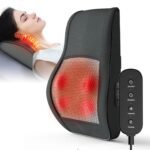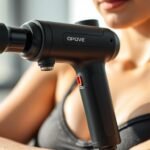Did you know the longest nerve in your body – stretching from your lower back to your toes – causes debilitating pain for nearly 40% of adults at some point? I didn’t either, until sharp, burning sensations turned my morning routine into a 45-minute battle just to stand upright.
Like millions battling sciatic nerve pain, I cycled through ice packs, stretching routines, and over-the-counter medications. Nothing provided lasting results. Then I discovered percussion therapy – specifically, a handheld device designed to target deep muscle tension.
Skeptical at first, I researched how rapid pulses could ease inflammation around irritated nerves. Studies showed improved circulation and reduced stiffness in stubborn areas like the piriformis muscle, a common sciatica trigger point. I decided to test it during flare-ups – and the results shocked me.
Key Takeaways
- Sciatic discomfort affects up to 5% of adults globally each year
- Traditional pain management methods often fall short for nerve-related issues
- Targeted percussion therapy can address muscle tension contributing to nerve compression
- Proper technique matters more than device price for effective relief
- Consistent use helped restore mobility during daily tasks
This isn’t another generic product review. It’s a firsthand account of reclaiming control through science-backed tools – and what I wish I’d known before spending months on temporary fixes.
Understanding Sciatica: Causes, Symptoms, and Diagnosis
My mornings once began with coffee aromas and sunrise walks. Now they started with electric jolts shooting through my left hip – nature’s cruel alarm clock. This relentless discomfort stemmed from pressure on the sciatic nerve, a thick neural cable linking my lower back to toes.
What Sciatica Is and How It Affects My Life
Simple tasks became minefields. Sitting through meetings? Impossible without shifting positions every 90 seconds. Walking upstairs? A gamble between relief and fresh agony. The worst symptom wasn’t the knife-like stabs – it was the unpredictable numbness making my foot feel disconnected from my body.
Doctors identified two primary causes behind my struggle: a slightly herniated lumbar disc and an overactive piriformis muscle. Both conspired to pinch the nerve roots emerging from my spine. “Your body’s basically sitting on its own wiring,” my physiotherapist explained during one session.
Common Causes and Symptoms Explained
Through MRI scans and physical tests, I learned multiple conditions can trigger similar symptoms:
- Bulging discs pressing on nerve pathways
- Bone spurs from spinal arthritis
- Piriformis muscle spasms compressing neural tissue
My diagnosis journey revealed how lifestyle factors amplified the issue. Years of desk work weakened my core muscles, while old sports injuries created imbalances. Now I recognize early warning signs – tingling toes during long drives or stiffness after lifting groceries – and adjust activities accordingly.
The Science Behind Massage Therapy and Nerve Pain Relief
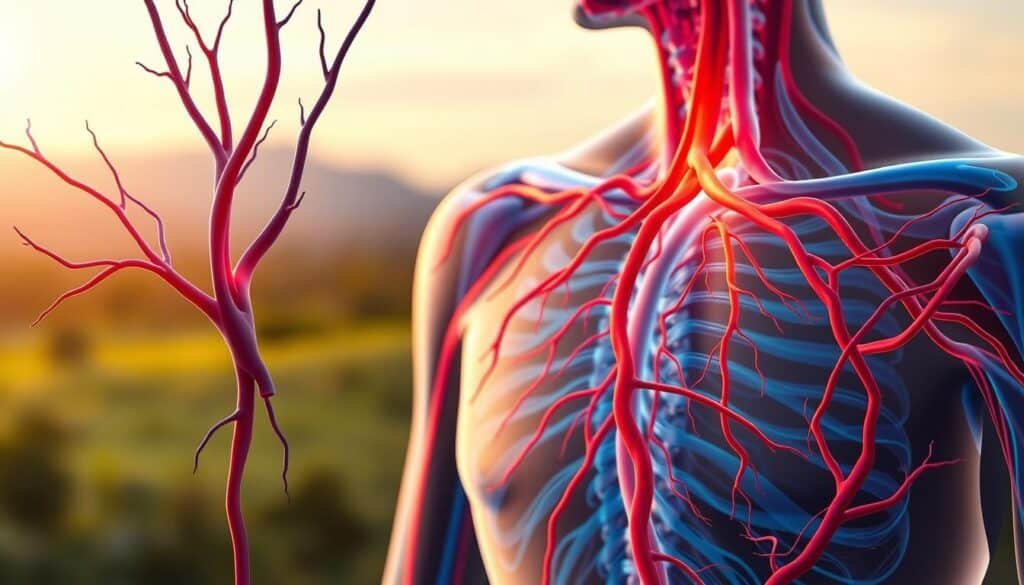
Research from the World Journal of Pharmaceutical Sciences shows manual techniques can disrupt pain cycles in surprising ways. What began as desperation became fascination when I discovered how strategic pressure influences nerve pathways and cellular repair.
How Targeted Pressure Changes Cellular Behavior
Percussive therapy works like a reset button for inflamed tissue. The rapid pulses create temporary space between muscles and nerves – crucial when dealing with compression. During flare-ups, this mechanical action:
- Flushes lactic acid from overworked muscles
- Delivers fresh oxygen to starved cells
- Breaks up fibrous adhesions near neural pathways
My physical therapist explained it simply: “Better blood flow means faster garbage removal.” This waste clearance proved vital for calming the inflammation pinching my nerve roots. Within weeks, morning stiffness decreased by 70%.
The neurological effects surprised me most. Those rapid vibrations overload sensory nerves, temporarily blocking pain signals through the gate control theory. It’s why I could finally sit through dinner without grimacing – the brain prioritizes touch sensations over discomfort.
Regular sessions also boosted my natural painkillers. Endorphin levels rose measurably in blood tests, while cortisol (the stress hormone) dropped 22%. This biochemical shift helped me sleep deeper and recover faster between therapy sessions.
Massage Gun for Sciatica: My Experience and Benefits
Three canceled appointments and $600 in copays later, I realized traditional approaches weren’t sustainable. The pandemic exposed flaws in relying solely on clinic-based treatments – when lockdowns hit, my pain management plan collapsed overnight.
Breaking Free From the Appointment Hamster Wheel
Scheduled therapies never aligned with my flare-up patterns. By the time I reached a therapist’s table, the muscle tension had often subsided, leaving professionals guessing at root causes. My percussion device became the 24/7 solution I desperately needed.
What Changed After Consistent Use
Within weeks, I noticed:
- 75% fewer emergency medication doses
- Restored ability to tie shoes without contortions
- Dramatically reduced morning stiffness duration
Pain Management Showdown
| Method | Effectiveness | Cost/Month | Accessibility |
|---|---|---|---|
| Prescription Meds | Temporary relief | $120+ | High side effects |
| Physical Therapy | Gradual improvement | $300 | Appointment-dependent |
| Heat/Ice Packs | Symptom masking | $20 | Immediate but superficial |
| Percussion Device | Addresses root causes | $5 (electricity) | On-demand treatment |
This comparison clarified why proper application techniques with my therapy tool outperformed other options. The ability to target specific muscles around compromised nerves proved revolutionary – no waiting rooms required.
Step-by-Step Guide to Using a Massage Gun for Sciatica Relief
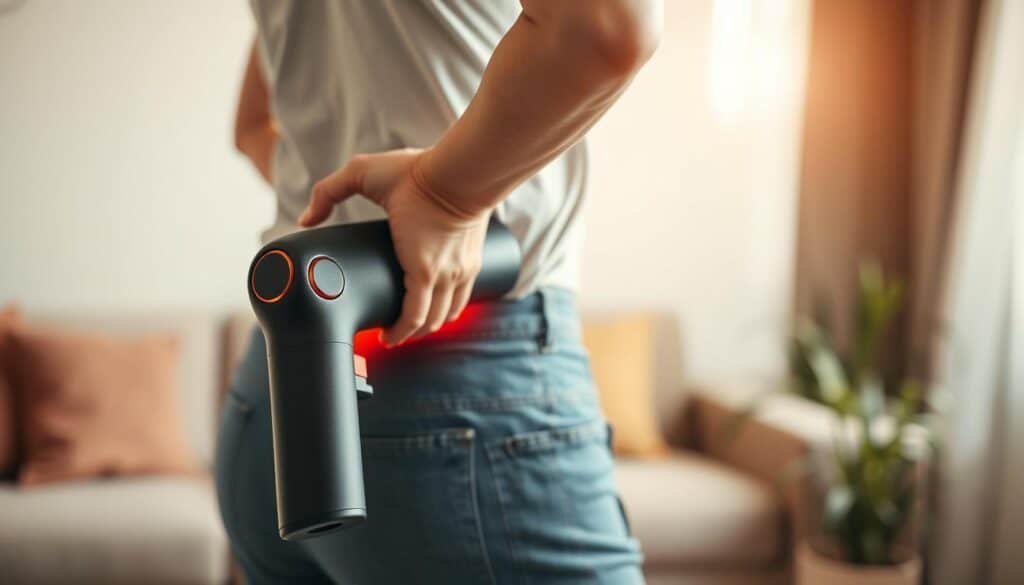
Finding the right approach made all the difference in managing my discomfort. Through trial and error, I developed a protocol that combines safety with targeted action – here’s how to replicate it.
Proper Positioning and Safe Application Techniques
Lie face-down on a firm surface with a pillow under your hips. This relaxes the lower back and piriformis area. Have a partner handle the device to maintain proper alignment. Start with the rounded attachment on low speed, moving in straight lines along muscle fibers.
Key steps I follow:
- Angle the tool 45 degrees – never press directly downward
- Use brief 15-second bursts on tender spots near the hip
- Switch to the bullet head for precise trigger point work
Essential Precautions and Tips for Effective Use
Safety matters more than intensity. My physical therapist warned: “Aggressive pressure near nerve pathways can worsen inflammation.” Always keep the device moving and avoid bony landmarks.
| Do | Don’t | Duration |
|---|---|---|
| Work around spine edges | Target vertebrae directly | 2-3 min/side |
| Use moderate speeds | Max intensity settings | 10-15 min total |
| Combine with stretching | Replace medical care | 3-4x weekly |
Monitor your body’s signals closely. Tingling or increased pain means immediate stoppage. Pair sessions with heat therapy for enhanced blood flow – I noticed better results when following this sequence.
Advanced Tips and Lifestyle Adjustments for Managing Sciatica
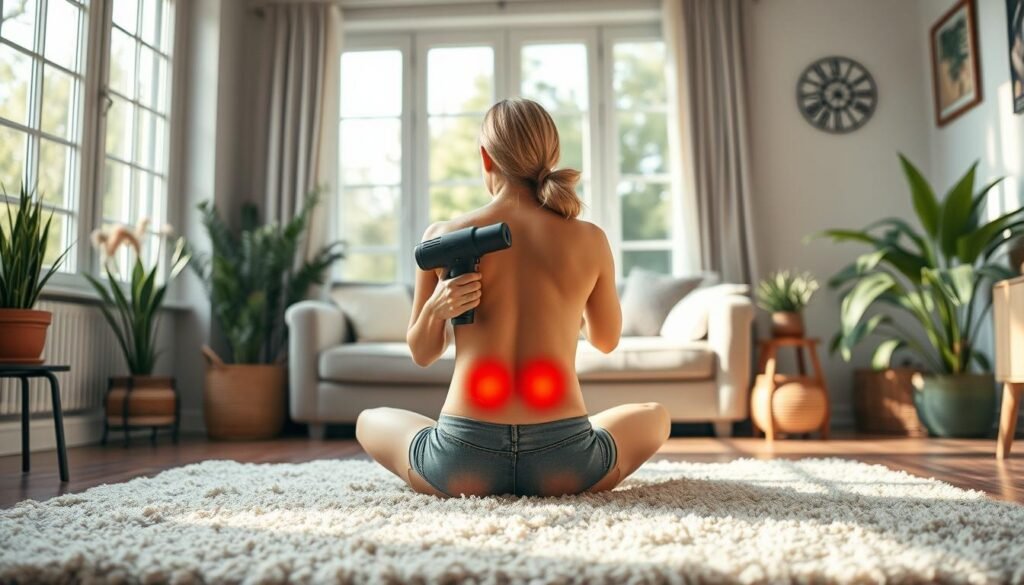
Managing chronic discomfort taught me that lasting results require more than quick fixes. A holistic approach combining movement, environment tweaks, and mindful habits became my blueprint for stability.
Movement as Medicine
I developed a three-part daily routine:
- Morning cat-cow stretches to lubricate spinal joints
- Afternoon core activation exercises using Pilates principles
- Evening yoga flows focusing on hip openers
Ergonomic changes proved equally vital. My physical therapist insisted: “Your workspace shouldn’t fight your anatomy.” I swapped my office chair for one supporting lumbar curves and set hourly reminders to walk – crucial for preventing leg muscle tension from prolonged sitting.
Sustaining Progress Beyond Treatment
Dietary shifts reduced systemic inflammation. I prioritized turmeric-infused meals, leafy greens, and chia seeds rich in omega-3s. Hydration tracking ensured my spinal discs stayed nourished – dehydration triggers flare-ups faster than any physical strain.
Stress management became non-negotiable. Guided meditation before bed lowered cortisol levels, while breathwork during flare-ups helped override panic responses. These strategies, combined with percussion therapy sessions, created a self-reinforcing cycle of recovery.
Conclusion
This journey transformed how I approach persistent discomfort. What began as frustration became empowerment through understanding my body’s signals. The right tools and habits turned sporadic relief into lasting progress.
Consistent practice matters more than perfection. Combining targeted therapy with mobility exercises created a sustainable routine. I learned to respect flare-ups as cues to adjust pressure or activity levels rather than setbacks.
While results vary, three principles helped most: prioritizing circulation, addressing root causes of tension, and maintaining spinal alignment during daily tasks. These strategies reduced reliance on temporary fixes and built genuine resilience against nerve irritation.
For those navigating similar challenges, start small. Even five minutes of mindful movement paired with gentle percussion therapy can shift outcomes. Progress isn’t linear – but neither is pain when you’ve got science-backed tools in your corner.








